by Dr Rob Liddiard, University of East Anglia
Flooding the Marshes
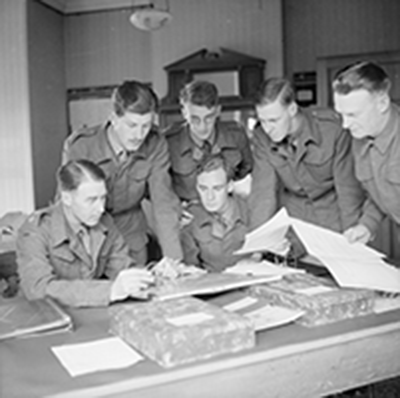
Image: The Royal Artillery (Imperial War Museum H11543).
During the Second World War the long beach at Minsmere was seen as vulnerable to a German landing. As a defence measure, the area behind the sand dunes was deliberately flooded to act as a barrier to any enemy who might try to make their way ashore.
The opening of the sluices to flood the Minsmere marshes was undertaken by the Royal Artillery. Despite the national emergency, the young officer standing in the centre of the photo (left) went to ask permission from the local landowner, but when they could not be found, flooded the marsh anyway
The area to the north of the Minsmere river was allowed to flood completely, while the area to the south was only to be flooded when an invasion was imminent. In June 1940 the sea sluice was opened and the door allowing the exit of freshwater from the river closed. When the whole of the north level was flooded, the sea sluice was closed and the area remained inundated until 1945, when the operation of the sluices returned to normal.
Beach Obstacles
In addition to the flooding of the marshes, the beach was covered with obstacles. Barbed wire, mines, lines of anti-tank blocks, anti-tank scaffolding and ‘Dragon’s Teeth’ – steel spikes set in concrete and intended to rip the bottom out of German landing barges – all formed part of the defences. The drainage channel running parallel to the beach was also widened to form a watery anti-tank ditch.
Pillbox
As the highest point in the landscape and with a building already offering the potential for camouflage, the hillock was an obvious site for a strongpoint. The ruins of a medieval chapel acted as a shell for a rectangular concrete pillbox that was built within the structure and provided with numerous firing points for infantrymen.
The placing of the pillbox here was to guard a minor entry point from the beach and a track that led inland. The men in the pillbox were not left to defend the area on their own, however, as heavy machine guns on Dunwich cliff to the north could sweep the whole beach with fire and field artillery guns placed behind the lines could shell the area in front of the pillbox.
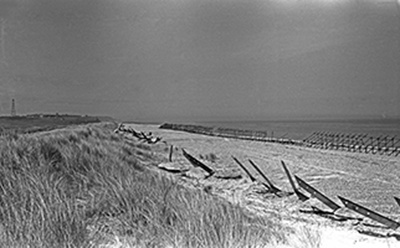
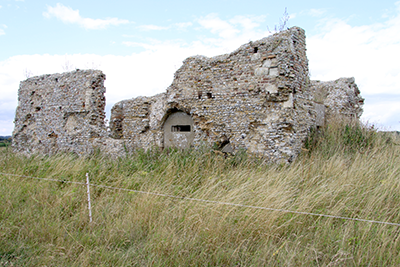
Image (left): Minsmere beach c.1949 showing partially dismantled anti-tank scaffolding and ‘Dragon’s Teeth’ waiting to be removed. In the background, the defences and radar station on Dunwich Heath can be seen (Eric Hosking Trust). Image (right): WWII pillbox hidden in the walls of the medieval chapel ruins (right)
Enemy Action
Standing in a flat landscape much of which was covered with water, the chapel site was an obvious target for German planes. During 1940 and 1941 this part of Suffolk was regularly attacked by low flying German aircraft and the pillbox was machine-gunned on 11th May 1941 as part of a longer strafing run by Messcherschmidt 109 aircraft and was reported in some detail by troops on the ground:
"At 2140 hrs 3 Me 109s approached WALBERSWICK from the North, two of them at 5,000 ft and one at approx. 250ft. This latter plan machine-gunned WALBERSWICK and then, further down the coast, a ruined chapel near SLUICE, TEA HOUSE, THORPENESS and ALDEBURGH were also subjected to machine-gun fire from this plane. No military casualties but one civilian at ALDEBURGH was injured”.
Creating a Habitat
Image: View of Minsmere marshes c.1949 showing the immediate post-war landscape and the tower of Dunwich Radar Station in the background.
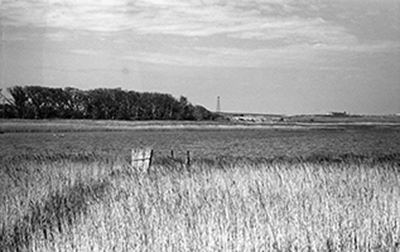
By the end of the war, the area around Minsmere comprised approximately 400 acres of watery pools with extensive reedbeds formed from the network of drainage channels. The wartime flooding of the marshes had, albeit accidentally, created a perfect haven for wild birds. This was the origin of the RSPB Minsmere bird reserve and in the decades that followed careful management has facilitated the development of one of the most significance wildlife habitats in the country.
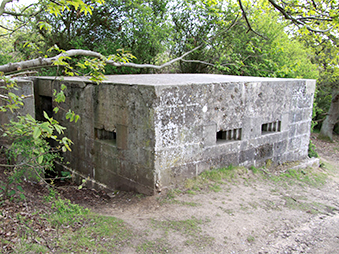
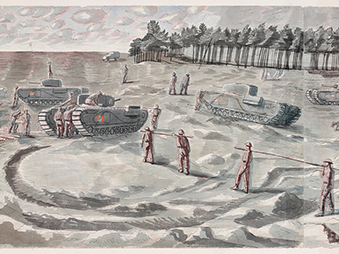
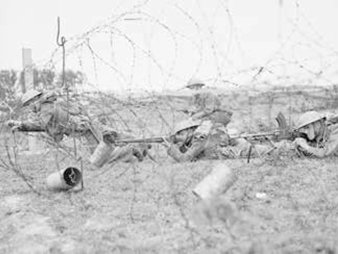
Second World War Guidebooks
a series of four guidebooks to Suffolk's Second World War archaeology
Discover More »